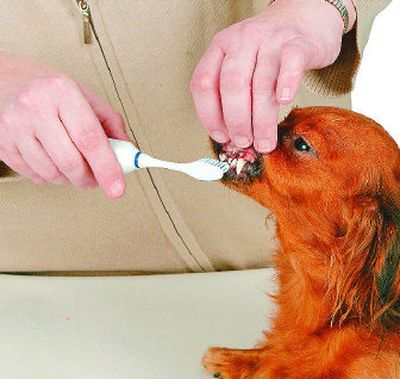Brushing boosts pet’s oral health

Dental disease will affect the health of most of our dogs and cats during their lifetime.
Brushing your pet’s teeth is by far the most effective way of preventing periodontal disease. If your pet already has periodontal disease, brushing will help slow its progression.
For adult and older animals, have your veterinarian examine them before starting to brush their teeth. If there is severe periodontal disease, dental tartar or broken or abscessed teeth, your vet will need to deal with these problems during a dental prophylaxis performed under general anesthesia.
Almost all puppies and kittens can be trained to accept tooth brushing, and since dental disease starts so early in life, this is the best time to start preventing it.
Most older dogs and many older cats also can learn to accept brushing. Your vet can give you helpful hints on how to do this. Here is one method:
Muzzle comfort
First let yout pet get used to having its muzzle, teeth and gums touched. Do this for 30 seconds to a minute.
You can dip your finger in some beef broth or canned tuna to facilitate this. Be patient.
Don’t actively restrain your pet or get frustrated. If your pet becomes anxious or resists handling, try again the next day.
Experiment with different treats to get it interested. The goal is to have your pet enjoy having its gums gently massaged.
Try the bristles
Next, let your pet lick something tasty off of a pet toothbrush or finger brush, to become accustomed to the feel of the bristles. Once it looks forward to the treat it will get from licking the brush, put some flavored toothpaste – made for pets – onto the brush.
Human toothpaste should never be used on your pet because of its high fluoride content.
Front first
While your dog or cat is licking the pet toothpaste off the brush, try to gently brush the front teeth and gums. Concentrate on the outer surfaces of the teeth and gradually work across all the teeth.
If your cat becomes impatient, try just doing the right side one day and the left the next. If your dog is very patient, you can brush the inner surfaces of the teeth as well.
Do it daily
Ideally, brush every day or at least, three times a week to reduce periodontal disease. Brushing once every four to six weeks as part of your pet’s grooming is useless unless you are doing it all the other days.
If you have a dog or cat that bites or is aggressive, don’t try to brush its teeth. You might want to ask your veterinarian about dental sealers that can be applied weekly.
Other methods
Although brushing is best, there are other tools that contribute to fighting dental disease, including prescription and over-the-counter dental diets. Ask your vet for a food recommendation.
Dental chews and oral rinses can be helpful. Chewing is a great way for dogs to exercise their teeth, and it can strengthen the supporting structures of the teeth and mouth. With any toy, dogs should be monitored to make sure they don’t chew off a piece too big to swallow safely.
Real bones can splinter or break teeth, and so can rawhide bones.
See a vet
It’s very important to have your pet’s dental health assessed by your vet at least once a year. Most pets need a dental prophylaxis every six to 24 months.
This procedure, which is performed during general anesthesia, includes ultrasonic scaling to remove tartar, polishing, fluoride treatment, a thorough dental exam to assess each tooth for periodontal pockets, discoloration or other signs that something is amiss, as well as dental X-rays and extractions, if indicated.
The newest thing in our arsenal is a canine vaccine directed at the bacteria that most often cause the destruction associated with periodontal disease.
It has just received conditional approval by the Food and Drug Administration. Although a vaccine cannot replace the steps mentioned above, it shows some promise to help to slow or reduce the severity of periodontal disease in dogs.